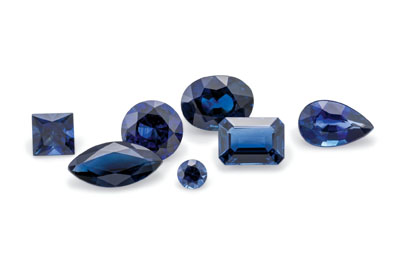History of Sapphire Jewelry
 Sapphire jewelry has a colorful [excuse the pun] history dating back
thousands of years. This rare and valuable vivid blue gemstone has been associated
with royalty and wealthy families. Cultures around the world still revere sapphire for its beauty and durability. In this
article, we'll explore the history of sapphire jewelry, how it has
evolved over time, and its significance today.
Sapphire jewelry has a colorful [excuse the pun] history dating back
thousands of years. This rare and valuable vivid blue gemstone has been associated
with royalty and wealthy families. Cultures around the world still revere sapphire for its beauty and durability. In this
article, we'll explore the history of sapphire jewelry, how it has
evolved over time, and its significance today.
Sapphire jewelry has proven its timeless appeal. Known for its deep, rich blue color, sapphire is a gemstone that has long been associated with royalty and luxury. Sapphires were first discovered in ancient Persia, now modern-day Iran, around 800 BC. They were treasured by the Persians who believed that the gemstone protected them from harm and envy. The Persians wore sapphires as talismans or amulets to ward off evil spirits and curses.
The ancient Greeks also valued sapphires and believed that the gemstone had powers of wisdom and truth. In fact, the word sapphire is derived via the Latin "sapphirus". This comes from the Greek word "sappheiros", which probably referred to lapis lazuli. The Greeks believed that sapphires could help reveal the secrets of the universe and bring good luck to those who wore them.
During the Middle Ages, sapphire jewelry became a symbol of royalty and power. Kings and queens would wear sapphire jewelry to signify their status and wealth. One of the most famous examples in the western world is the "St. Edward's Sapphire". This octagonal, rose-cut sapphire is currently set in the Imperial State Crown of England. While this sapphire is said to have been re-cut over the years, historians trace it all the way back to the 11th century. It is said to have been originally set in the coronation ring of Edward the Confessor, who became king in 1042. The particular sapphire is regarded as the oldest gem in the royal collection.
In the 18th and 19th centuries, sapphire jewelry became popular among the upper classes in Europe and the United States. The discovery of large sapphire deposits in Australia fed the supply of raw material. This led to a surge in the production of sapphire jewelry. Sapphires were often set in gold or silver and were used in everything from necklaces and brooches, to bracelets and earrings.
During the Art Deco movement of the 1920s and 1930s in Europe and the United States, sapphire jewelry became even more popular. Art Deco jewelry is characterized by geometric shapes and a focus on color and contrast. Sapphires were often used as accent stones in Art Deco jewelry, and their rich blue color added a touch of luxury and exuberance to the designs.
Today, sapphire rings remain treasured and valuable. In 2011, the royal wedding of Prince William and Kate Middelton drove the public's love for sapphire to new heights. Prince William's engagement ring for Catherine, Duchess of Cambridge, holds great sentimental value as it once belonged to his late mother, Princess Diana. The sapphire and diamond ring features a 12-carat oval-shaped blue Ceylon sapphire surrounded by 14 round diamonds set in 18 karat white gold. The ring was chosen by Prince William himself as a way to honor his mother's memory and legacy. Its timeless design and rich history have made it one of the most famous engagement rings in the world, and it continues to be a symbol of enduring love and devotion.
Sapphire jewelry has a timeless and classic appeal that is hard to resist. Sapphire's rich blue hue make it one of the most popular gemstone colors in the world. However, sapphires are not limited to blue, they can be found in many other colors such as pink, yellow, green, and even black. This versatility of colors makes sapphires a popular choice for jewelry makers and wearers alike. Sapphire jewelry is often used for engagement rings and anniversary gifts, and it is sure to be cherished for a lifetime. Whether you prefer a simple sapphire pendant or an elaborate sapphire and diamond ring, sapphire jewelry exudes elegance and sophistication.





